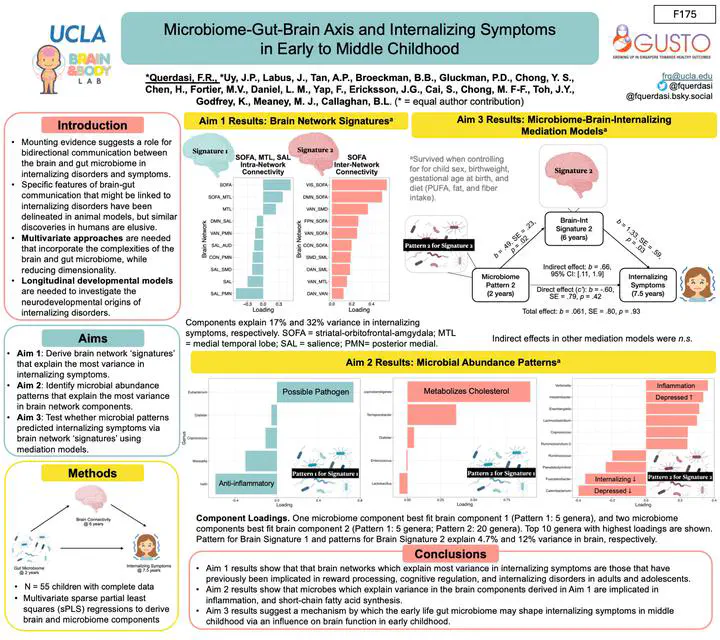Microbiome-Gut-Brain Axis and Internalizing Symptoms in Early to Middle Childhood

Event: Society of Biological Psychiatry 2024 Annual Meeting
Location: Austin, Texas, USA
Authors: *Querdasi, F.R., *Uy, J.P, Labus, J.L., Tan, A.P., Broeckman, B.B., Gluckman, P.D., Chong, Y. S., Chen, H., Fortier, M.V., Daniel, L. M., Yap, F., Ericksson, J.G., Cai, S., Chong, M. F-F., Toh, J.Y., Godfrey, K., Meaney, M. J., Callaghan, B.L.
*indicates co-first authors
Poster Abstract:
Background: Internalizing disorders have developmental origins, but little is known about how microbiome-gut-brain axis development contributes to internalizing symptoms in childhood.
Methods: N=55 children from the Growing Up in Singapore Towards Healthy Outcomes study participated. We used sparse partial least squares regression to identify resting state functional brain networks at age 6 years associated with internalizing symptoms at age 7.5 years. We then identified compositional features of the gut microbiome at age 2 years that were prospectively related to these brain-internalizing ‘signatures’, and tested whether brain signatures mediated links between gut microbes and childhood internalizing symptoms. Covariates included child sex, birthweight, gestational age, and diet.
Results: Two orthogonal brain components best explained variance in internalizing symptoms (17% and 31% respectively): Component 1 (20 networks - higher intra-network connectivity of striatal-orbitofrontal-amygdala [SOFA] and medial temporal lobe [MTL] networks, and lower salience network connectivity); Component 2 (15 networks - higher inter-network SOFA connectivity). One microbiome component (A: 5 bacterial genera) best fit brain Component 1 and two microbiome components (B: 5 genera; and C: 20 genera) best fit brain Component 2. Mediation analyses found microbiome Component C (which included several genera implicated in youth depression; e.g., Intestinibacter) was associated with internalizing symptoms via brain Component 2 (SOFA inter-connectivity; ab path = .66, 95% CI: [0.11, 1.9]).
Conclusions: These data demonstrate a developmental link between gut microbes in early childhood and brain networks associated with internalizing symptoms in school-aged youth. Gut microbes may thus represent an important early intervention target with implications for brain development and behavior.
Funding Sources: The GUSTO project is funded the National Research Foundation (NRF) under the Open Fund-Large Collaborative Grant (OF-LCG; MOH-000504) administered by the Singapore Ministry of Health’s National Medical Research Council (NMRC) and the Agency for Science, Technology and Research (A*STAR). Research reported in this abstract was also supported by the National Institute of Mental Health (NIMH) of the United States National Institutes of Health (NIH) under award number T32MH015750 to FRQ. MJM is supported by grants from the JPB Foundation (USA) and Hope for Depression Research Foundation (USA). We would like to acknowledge the UCLA Goodman-Luskin Microbiome Center Integrative Biostatistics and Bioinformatics Core providing their services in collaboration on statistical analysis (via Microbiome Seed Fellowship to FRQ and BLC).